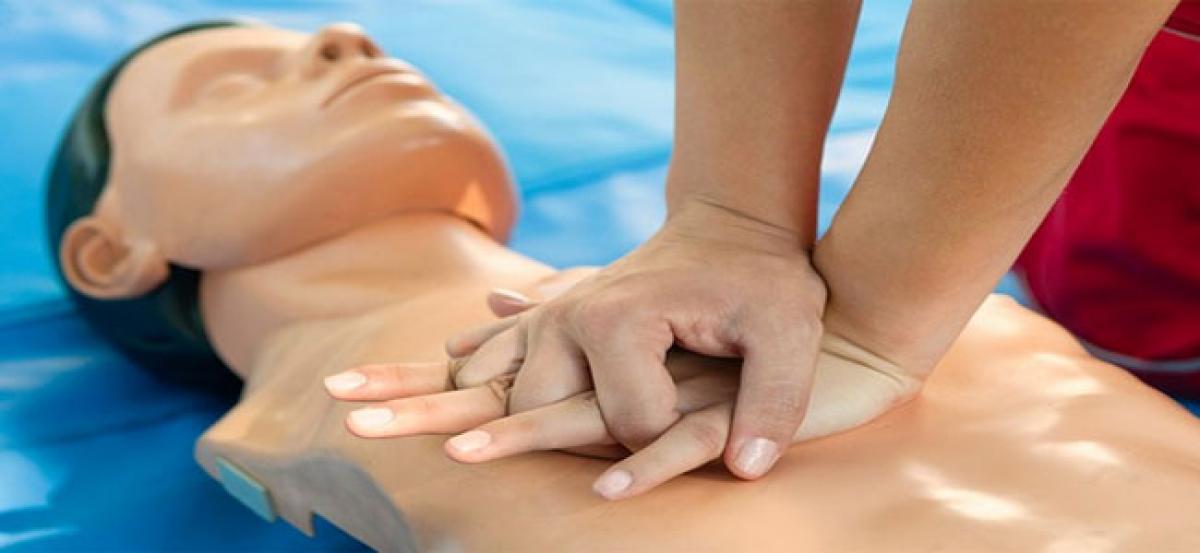Live
- Red Cross blood centre inaugurated
- Fee Reimbursement Dues: TG private colleges to shut down from today
- HYDRA razes illegal structures in Ameenpur
- Famed Vemulawada shrine to get Rs 76 cr fund push for makeover
- Over 77L digital life certs generated by pensioners
- Setback for RGV as HC refuses to quash case against him
- PM Modi interacts with Joe Biden in Rio de Janeiro
- India rated as fastest growing G20 economy
- Maha campaign ends, polls tomorrow
- Assailants of Cong leader held after encounter; 2 hurt
Just In

There is an urgent need to make CPR (Cardio-Pulmonary Resuscitation) training a must in schools and colleges and even at community level so that family members of those people
New Delhi: There is an urgent need to make CPR (Cardio-Pulmonary Resuscitation) training a must in schools and colleges and even at community level so that family members of those people, who fall under high risk zone for developing heart ailments, can give immediate medical assistance in times of emergency when the breathing or heart beats stop.
CPR is a lifesaving technique useful in many emergencies, including heart attack or near drowning in which someone's breathing or heartbeat stops.
Most of the people are unaware of the technical term Cardiopulmonary Resuscitation and do not know proper technique of doing CPR in emergency situation. Knowing how to give CPR properly can be a great asset and can save life of a person when his or her heart stops beating.
The following simple steps can be performed for giving CPR to a person:
1. If someone is lying unconscious, check for his pulse and breath
2. Tilt the head and lift the chin to open the airway
3. Give mouth to mouth respiration for (Give 2 full breaths for 2 seconds)
4. Give-chest compression or push hard on victim's chest (Give 30 compression.) Compression should be performed at the rate of almost 2 per second
A person who has a family history of high blood pressure, smoking or tobacco use, obesity, diabetes or high blood cholesterol will fall under high risk zone of developing heart ailments.
"Any process to bring back the heart beats in the first minute is very important and CPR is one very effective and time tested process. There should be a concerted effort to make CPR training a must. The government can also come out with campaigns and such training should be given to all and sundry. Government and private hospitals should also be roped in for providing training, apart from making it compulsory in schools and colleges. NGOs can also be of great help in such an initiative" said Dr Piyusha Majumdar, Assistant Professor, IIHMR University Jaipur.
At the same time, proper heart examination should also be made part of routine health check up among the people in the county. People get heart checkups like ECG and Angiography done only when they face some problems like chest pain or any other symptom of heart attack or cardiac arrest.
Cardiovascular disease (CVD) is the leading cause of mortality in urban and rural India, causing more than 11 percent of deaths and more than 5 percent of years of health life lost due to morbidity or premature mortality in 2010. In terms of acute cardiovascular diseases, the burden has been found to be distributed among a relatively young population.
"The need to make heart examination part of the routine health check up is also important because the level of knowledge and familiarity with heart conditions among the people is mainly limited to heart attack but understanding of other heart ailments like Enlarged Heart and Ischemic Heart is quite limited," said Dr Majumdar.
Ischemia means "reduced blood supply". Ischemic Heart means there is reduced blood supply to the heart. Ischemic heart disease has emerged as number one killer in almost all states of India.
Presently, there is little data in India on efforts or knowledge translation in prevention, treatment, and management of acute CVD. In addition, successful strategies for Emergency Medical Services and effective treatment protocols for acute CVD are also less than optimal due to system constraints and lack of commitment from patients and health care providers.

© 2024 Hyderabad Media House Limited/The Hans India. All rights reserved. Powered by hocalwire.com







